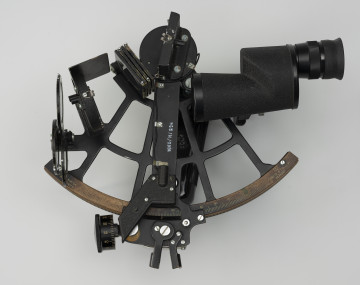
Max indication clinometer
1977
National Museum in Szczecin
Part of the collection: Navigation history
A clinometer is an instrument fitted with a pendulum function that swings against a scaled dial which reads the value of the angle by which the ship is tilted at any given time. The angular scale is designed to indicate the tilt values both to starboard and port, so that the zero value is placed in the centre indicating when the ship is at rest. Two extra hands show the maximum recorded tilt/list of the vessel independently for the starboard and port sides. Every vessel, after construction or major refurbishment that may affect the centre of gravity, undergoes an inclining test. This involves moving specific weights from side to side and measuring the angles of tilt obtained in order to calculate the co-ordinates of the centre of gravity and the metacentric height, as well as correcting, theoretically calculated, righting moment arm curves relevant during high heeling. These values, together with additional data such as centre of buoyancy, buoyancy force, and the vessel's gravity, are used to determine stability. This is a naval architecture term for the ability of a vessel to withstand external forces such as gravity, sea waves and wind that may cause it to capsize, and is therefore fundamentally concerned with safety. Ship stability criteria are defined by Polish and international regulations and may additionally depend, among other things, on the type of cargo being carried. Ship crews are required to constantly check the ship's heel, which is important not only during stormy weather, when the waves at sea are large and wind gusts can be strong and violent, but also when changing course and loading and unloading the ship in port. Models, as the one featured, may have been used on a variety of vessels. An identical, albeit earlier copy bearing a smaller serial number, is in the collection of the National Maritime Museum in Gdańsk (CMM/S/177) and represents the outfitting of s.s. "Sołdek", the first steel seagoing ship built in Polish shipyards after the Second World War, the home port of which was Szczecin. Leszek Kocela
Author / creator
Object type
clinometer
Technique
batch production
Material
metal, brass, nickel, glass, plastic
Origin / acquisition method
purchase
Creation time / dating
Creation / finding place
Owner
Muzeum Narodowe w Szczecinie
Identification number
Location / status

1977
National Museum in Szczecin

1960 — 1970
National Museum in Szczecin

1983-02-28
National Museum in Szczecin
DISCOVER this TOPIC
Castle Museum in Łańcut
DISCOVER this PATH
Educational path